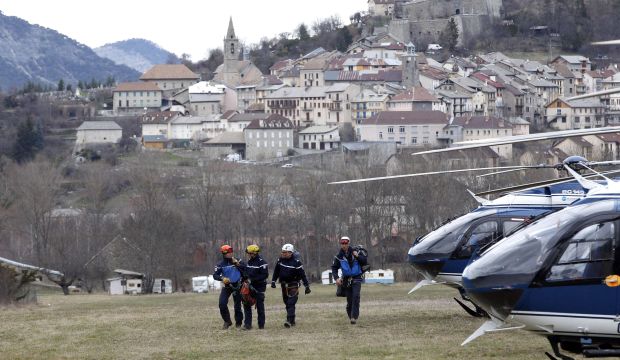
Rescue workers near the crash site of the Germanwings Airbus A320 in Seyne-les-Alpes, France, on March 25, 2015.
(AFP Photo/Pool/Christophe Ena)
Seyne-Les-Alpes, France, Reuters—Lufthansa said on Wednesday it could not explain why its Germanwings Airbus had crashed into an Alpine ravine killing all 150 on board as investigators tried to discover what had caused the first major air disaster in France in 15 years.
Investigators said the remoteness of the crash site meant it could be days before a clear picture emerged of Tuesday’s tragedy.
However they said the fact that debris was restricted to a small area showed the A320 was not likely to have exploded in mid-air, suggesting a terrorist attack was not to blame.
“It is inexplicable this could happen to a plane free of technical problems and with an experienced, Lufthansa-trained pilot,” Lufthansa chief executive Carsten Spohr told reporters in Frankfurt.
Lufthansa said the 24-year-old plane had on Monday had repairs to the hatch through which the nose wheel descends for landing. A spokeswoman said that was not a safety issue but that repairs had been done to reduce noise.
Police and forensic teams on foot and in helicopters investigated the site about 65 miles (100 kilometers) north of Nice where the airliner came down en route to Dusseldorf from Barcelona.
“When we go to a crash site we expect to find part of the fuselage. But here we see nothing at all,” said pilot Xavier Roy, coordinating air operations.
Roy said teams of investigators had been dropped by helicopter onto the site and were working roped together at altitudes of around 6,000 feet (2,000 meters).
It would take at least a week to recover all the remains of the victims, he said.
No distress call was received before the crash, but French authorities said one of the two “black box” flight recorders, the cockpit voice recorder, had been recovered, albeit in need of repair.
“The black box has been damaged. We will have to put it back together in the next few hours to be able to get to the bottom of this tragedy,” Interior Minister Bernard Cazeneuve told RTL radio.
In all, 72 Germans were killed in the crash, the first major air passenger disaster on French soil since the 2000 Concorde accident just outside Paris. Spanish officials said 49 Spaniards were among the victims.
French President Francois Hollande was being joined by Germany’s Angela Merkel and Spain’s Mariano Rajoy to pay their respects to the victims and to meet search teams at their base in the nearby village of Seyne-les-Alpes later on Wednesday.
Other victims included an American, a Moroccan and citizens of Britain, Argentina, Australia, Belgium, Colombia, Denmark, Israel, Japan, Mexico and the Netherlands, French officials said. However DNA checks to identify them could take weeks.
Germanwings said it cancelled one flight on Wednesday and was using 11 planes from other carriers for about 40 flights after some of its crew members had refused to fly.
Employees laid candles and flowers by Germanwings headquarters at Cologne/Bonn airport, while Lufthansa and Germanwings staff worldwide held a moment of silence at 10:53 am local time (9:53 am GMT)—the moment the plane went missing.
Among the victims were 16 teenagers and two teachers from the Joseph-Koenig-Gymnasium high school in the town of Haltern am See in northwest Germany. They were on their way home after a Spanish exchange visit near Barcelona.
The school held a day of mourning on Wednesday. A hand-painted sign said simply: “Yesterday we were many, today we are alone.”
“On Tuesday last week we sent off 16 happy young people, with two happy young colleagues, on a journey and what was meant to be a happy trip . . . has ended in tragedy,” headmaster Ulrich Wessel told reporters.
Barcelona’s Liceu opera house said two singers, Kazakhstan-born Oleg Bryjak and German Maria Radner, died while returning to Dusseldorf after performing in Wagner’s Siegfried.
Germanwings said on Tuesday the plane started descending a minute after reaching cruising height and lost altitude for eight minutes. Experts said that while the Airbus had descended rapidly, it did not seem to have simply fallen out of the sky.
The A320 is one of the world’s most used passenger jets and has a good safety record.
At 24 years old, the plane was older than many other planes at Lufthansa, where the average age of its fleet is 11.5 years. The plane was delivered to Lufthansa in 1991 and had clocked up around 58,000 flight hours over the course of over 46,000 flights, Airbus said.
